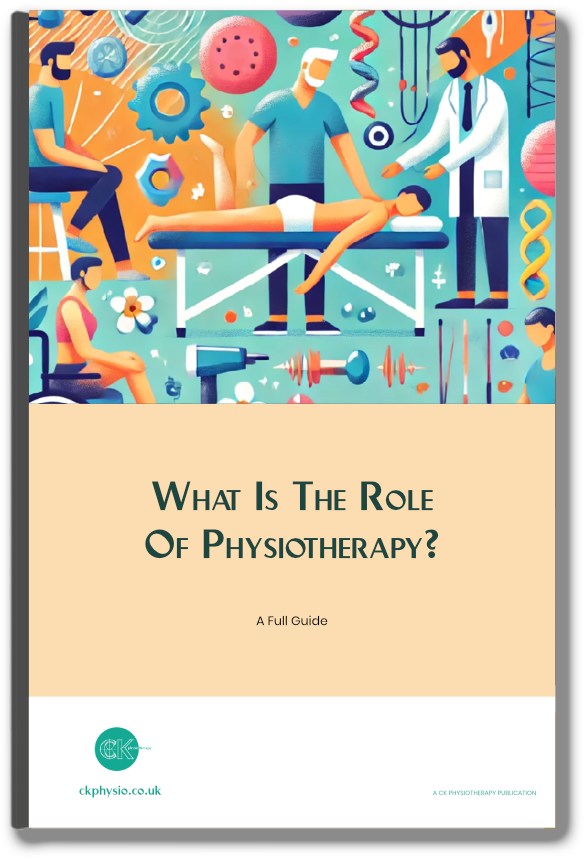
What Is The Role Of Physiotherapy? A Full Guide
If you’re struggling with ongoing muscle pain, have aches in your joints that reduce your mobility, or have a frustrating injury that’s preventing you from enjoying the sports and activities you love - it can have a huge impact on your quality of life.

If you do find yourself suffering from any physical condition that causes pain or limits movement, it’s important to book an appointment with your GP. They will be able to properly diagnose your condition and present you with the most appropriate treatment options.
Physiotherapy treatment is often recommended as an effective option for a wide range of musculoskeletal issues, such as muscle strains and sprains, painful joints, and repetitive strain injuries. It can also be effective in the rehabilitation of patients recovering from surgery or strokes and can ease the symptoms of chronic conditions such as multiple sclerosis.
Physiotherapy treatment also has a preventative and performance-optimisation aspect, with many athletes opting for regular sessions to help them remain injury-free and perform at their best.
But with the applications and benefits of physiotherapy being so broad and diverse, it can often be misunderstood.
In this guide, we’re going to demystify physiotherapy, looking at:
- Types of physiotherapy treatments: All you should know
- Back pain: Causes and physiotherapy treatments
- How can sports physiotherapy help you with injury recovery?
- Plantar fasciitis: Can physiotherapy help?
- Shockwave therapy for acute and chronic injuries
- Is shockwave therapy painful?
- CK Physio: Tailored physiotherapy treatments in West London
Types of physiotherapy treatments: All you should know

There isn’t a ‘one size fits all’ approach to physiotherapy.
Each one of us is different, with our own medical history, fitness levels, and lifestyle habits.
Every injury and condition is also unique based on its severity, how it affects the body, and how it impacts quality of life.
So, it’s important to choose an experienced, licensed physiotherapist who can design a tailored, individualised treatment plan to get you on the road to recovery.
Most experienced physiotherapists will start with an initial assessment, reviewing your medical records and asking about your symptoms and personal circumstances.
This is typically followed by a physical assessment to understand your range of motion, and examine the source of any pain and discomfort to pinpoint the root cause of your condition.
This helps a physiotherapist come up with a personalised treatment plan that is tailored to your circumstances and specific condition.
The role of physiotherapy in your treatment plan is likely to consist of a combination of the following techniques.
Manipulative therapy
This is a hands-on technique that can be used to treat muscle injuries, joint pain, and stiffness and even release stress and tension in tight muscles.
Soft tissue massage and mobilisation
This can be seen as a variation of manipulative therapy, focusing on the hands-on massage and stimulation of muscles and surrounding tissues to relieve tension, reduce pain, and improve circulation.
Posture and muscle imbalance correction
If you have an ongoing condition that could be caused by incorrect posture, your physiotherapist might look at how you sit, stand, and move to see if there are any issues or habits that are likely to be causing a problem.
If any issues are found, your physiotherapy treatment might include advice and exercises to help you improve your posture and correct any muscle imbalances.
Active and passive exercise therapy
Exercise therapy is a common form of physiotherapy treatment that is great for helping improve strength and range of motion.
Active exercise therapy involves exercises that you complete yourself with the guidance of your physiotherapist. Passive exercises involve having the physiotherapist move your body for you.
Lifting and manual handling instruction
If the root cause of your discomfort comes from incorrect lifting techniques, your physiotherapist might advise on the best way to lift and manoeuvre heavy objects at work or at home to help prevent further aggravation or future injuries.
Ergonomic advice
Lower back pain is common for people who work at desks all day and sit in a position that puts strain on their spine and lower back.
Your physiotherapist can provide helpful tips or suggest equipment that helps you work more comfortably and puts less stress on your body.
Exercise management
A personalised exercise plan might be creative for you to practise at home to help you improve strength and resilience, recover from injury, or prevent conditions from reoccurring.
Electrotherapy
Electrotherapy uses gentle electric currents to help reduce pain, stimulate muscles and tissue, and increase circulation.
Acupuncture
Acupuncture involves your physiotherapist putting tiny needles into different parts of your body to help alleviate pain, reduce inflammation, and promote healing.
Shockwave therapy
Shockwave therapy is an innovative treatment that can be used for a number of conditions that might not respond to traditional forms of physiotherapy.
It uses sound waves to create small micro-traumas in tissue, promoting your body’s natural healing response and improving blood flow to affected areas.

Download this as a PDF
Simply fill out this form to receive a PDF version of our guide.
Back pain: Causes and physiotherapy treatments

So, what is the role of physiotherapy in treating your back pain?
Back pain is a common issue, affecting millions of people worldwide. It’s actually estimated that up to 80% of people will suffer from back pain at some point in their lives.
It can be a complex condition to treat, as there are a whole range of causes that can lead to you suffering from pain in your back.
Acute back pain occurs suddenly and is often caused by muscle strains or sprains stemming from an incorrect lifting technique or suddenly twisting and turning while playing a sport. The cause of your acute back pain is often relatively easy to identify, so it can generally be straightforward for your physiotherapist to treat.
Where things become more complicated is if you have back pain that persists for three months or more, which is known as chronic back pain. There is a wide range of causes for chronic back pain, which could be as simple as poor posture at work but could relate to more serious medical conditions such as fibromyalgia, herniated discs, or spinal stenosis.
If you suffer from chronic back pain, it's possible you might need tests, x-rays, or MRI scans to help identify the root cause of the issue before any physiotherapy for back pain begins.
The role of physiotherapy in treating back pain can include a wide range of treatments, such as:
- Active and passive exercise therapy
- Massage
- Electrical stimulation
- Traction
However, biofeedback therapy is a more innovative and increasingly popular form of back pain treatment. It uses sensors to provide feedback on how the body responds to pain.
By being aware of your pain and how your body is responding, your physiotherapist can help you control it through deep breathing, meditation, and progressive muscle relaxation.
How can sports physiotherapy help you with injury recovery?

If you're an athlete who's dealing with an injury, it can be an incredibly frustrating experience. All you want is to be able to participate in your favourite sport and perform at your best.
But don't be tempted to power through the pain, as you run the risk of further aggravating your injury and ending up with a longer recovery time.
Sports physiotherapy can help athletes of all ages recover from injuries quickly and safely.
A trained physiotherapist can help you return to enjoying the sport you love and performing at your best through techniques like deep tissue massage, electrotherapy, and exercise therapy.
And if you're an athlete who wants to take a preventative approach to injuries or boost your performance, your physiotherapist can look at exercise programs designed to improve your resilience and help you reach peak condition
Plantar fasciitis: Can physiotherapy help?

Imagine not being able to walk, run, or even stand without wincing from the pain in your heel.
This is the reality for anyone suffering from plantar fasciitis - and it's more common than you might think, with 10% of people likely to suffer from it at some point in their lives.
Plantar fasciitis is caused by inflammation of the plantar fascia, the band of tissue that runs along the bottom of your foot.
Common symptoms are a sharp pain in your heel whenever you move and a tingling or burning sensation in your foot. In severe cases, the condition can even cause some people to limp to avoid putting pressure on their foot.
Certain people are more at risk of suffering from plantar fasciitis than others. If you're overweight, a frequent runner, or stand for prolonged periods of time at work, you increase your risk of developing this condition.
The good news is that most cases of plantar fasciitis can be treated with physiotherapy exercises or custom orthotics that are inserted into your shoe to relieve pressure on your plantar fascia.
For more severe cases that don't respond to initial treatment, your physiotherapist might recommend steroid injections, minor surgery, or shockwave therapy.
Shockwave therapy for acute and chronic injuriesatient video diaries

If you have a persistent injury that traditional physiotherapy approaches haven't been able to heal, your physiotherapist might recommend shockwave therapy.
Shockwave therapy works by delivering acoustic pulses to injured areas to help reduce pain, improve circulation, and promote healing.
It's a versatile approach that is suitable for both acute and chronic injuries.
There are two types of shockwave therapy - focal and radial.
Focused shockwave therapy delivers higher-energy waves to a focused area, making it ideal for treating deep-tissue injuries like plantar fasciitis and patellar tendinopathy.
Radial shockwave therapy delivers lower energy waves over a wider area, making it ideal for treating injuries closer to the surface of the skin, such as tennis elbow and jumper’s knee.
Is shockwave therapy painful?

One of the most common questions about shockwave therapy is whether or not it hurts.
The good news is that most patients report only slight discomfort during the procedure rather than any actual pain.
However, some patients do suffer from minor side effects such as tenderness, swelling, and increased sensitivity in the treated area.
Your physiotherapist should make you aware of all the potential side effects if it’s suggested as a form of treatment, so you’re able to make an informed decision.
It's also worth noting that shockwave therapy is not suitable for everyone.
If you're pregnant, have a pacemaker, or have conditions such as cancer, thrombosis, or epilepsy, shockwave therapy isn't recommended.
CK Physio: Tailored physiotherapy treatments in West London

If you live in the West London area and you're dealing with aches and pains or a frustrating sports injury that just won't go away, CK Physiotherapy is here to help.
We understand that every patient and condition is unique, which is why we go through a thorough four-step process to understand your circumstances and the nature of your injury before designing an individualised treatment plan.
Our team of chartered, licensed physiotherapists have experience in a wide range of physiotherapy techniques, including
Manipulative therapy
Soft tissue massage and mobilisation
Posture and muscle imbalance correction
Active and passive exercise therapy
Lifting and manual handling instruction
Exercise management
Electrotherapy
Acupuncture
Shockwave therapy
And we’re easy to get to. Our physiotherapy clinic is located in the heart of West London, is easily accessible by public transport, and has plenty of parking spaces.
So, if you're ready to say goodbye to that frustrating injury and reclaim your quality of life, book an appointment with CK Physiotherapy today.







.svg)
.svg)